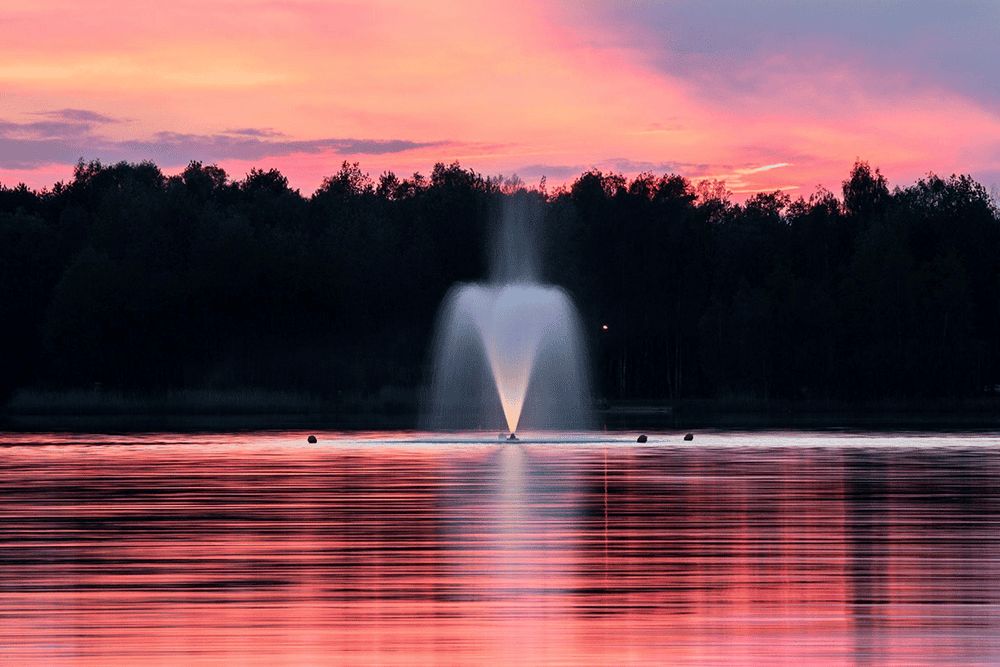Advantages Of A Fountain for a Pond

Water fountains are accessories that are entertaining, refreshing, and calming. A fountain is a terrific way to add tranquility to your waterfront environment, and whether it’s a lake or pond, it’s not only pleasant to hear but also beautiful to look at. At the same time, fountains aerate your pond and make it healthier for fish and plants.
Improve The Overall Quality of Your Water With Aeration
On top of the beauty of a fountain in your pond, it is also beneficial because it both churns the water and aerates it.
Pond aeration is needed for fish health and the overall ecological balance in the pond. One of the worst things that can happen to a pond is fish kill, but even without fish, the bottom layer of the pond will be depleted of oxygen depleted of oxygen and will accumulate muck, and the newer plants in the pond will decompose more slowly than the old older ones, creating the muck, thus sending up noxious gas bubbles to the surface. There is good algae and bad algae, and chances are without enough aeration the bad algae will out-compete the good.
 Fish Kill!
Fish Kill!
 Unwanted Stagnation and Algae
Unwanted Stagnation and Algae
Different Kinds of Fountains
Surface Aeration
The most common type of aeration is surface aeration. A float is used to suspend a pump in the water. The float allows the whole unit to rise and fall with changes in the water level. The pump churns the water below and at the same time aerates your pond.
But only to a degree. How much aeration occurs depends on what kind of surface fountain you are using.
The first kind is the decorative fountain. A nozzle is attached to the top of the float to create a desired flow pattern. The holes which create the pattern also have the effect of restricting water flow, so pure decorative fountains do not aerate as well as the other two kinds of surface aerators. Also, these fountains use impellers and do not produce as much flow as propeller-driven units.
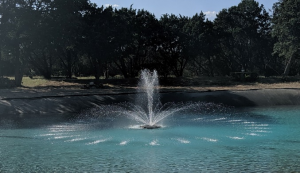 Decorative Fountain by Fountain Tech
Decorative Fountain by Fountain Tech
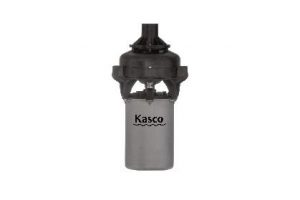
The aerating fountain is another kind of fountain display but only offers a single pattern, the V-shape. Water escapes the top of the pump through one very large hole, thus not restricting water flow as much. A propeller is used instead of a propeller.
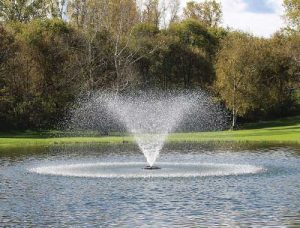 A Kasco aerating fountain. Notice V-shape
A Kasco aerating fountain. Notice V-shape
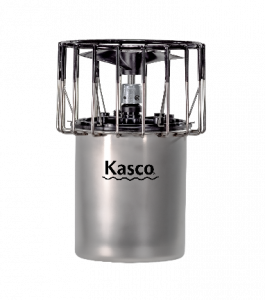
The pure surface aerator is comprised of only the float and pump. There is no restriction at all on the water output, and it merely bubbles or looks as though it’s boiling at the surface. It also uses a propeller.
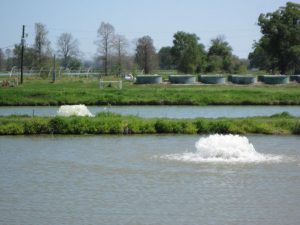
Surface Aerator, No Display
Bottom Aeration Using Diffusers
For very deep ponds (over 7’) bottom aeration is recommended. An air compressor is located at the shore and a hose carries the air to a diffuser unit at the bottom of the pond. Though compressors used to be rather loud, nowadays they are much quieter. They are also very energy-efficient, and a great deal of aeration can be done with a quarter horsepower compressor. They need to be housed to protect from the elements, thus quieting them more. If your pond is shaped conventionally, as a rectangle or oval, then it’s often the case you will only need a single diffuser at the bottom of the pond. If it has islands or unusual shapes, there’s a good chance you will need to place more than one diffuser at the bottom. 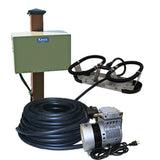
A diffuser unit with post mount cabinet for housing compressor
Combining the Two Kinds of Aeration
If you have a deep pond but still want to see a fountain, you can combine the two types of aerators, surface aeration and bottom aeration. The fountain would not need to aerate as much and could focus on height and width and dramatic display. This focus allows for a greater range of price as well as dramatic viewpoint. Two and three horsepower pumps are often needed to surface aerate ponds, whereas a much smaller fountain pump can be used if you combine with bottom aeration, which is less expensive.
About Solar Aeration
The goal is to eliminate the necessity of cords going to an electrical junction and to sidestep electricity bills. These units can be quite expensive, but they are built to be used with both surface and bottom aeration. Remember, though, that these units only run in sunshine– unless you have battery backup. Even when the sun is out, how sunny it is and direction of your solar panels will change the amounts of solar energy, so it’s a good idea to use a pump with variable speed. 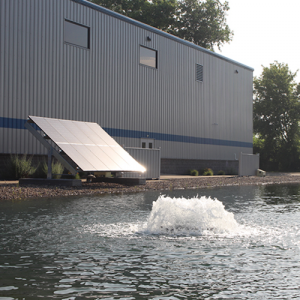 Kasco Solar Surface Aerator
Kasco Solar Surface Aerator
Windmill Aeration
Wind units are pretty to look at, but it can take many hours or days to install one. Like solar needs sunlight, wind aeration needs wind, and when is absent, there is no natural rippling of water at the pond’s surface, the exact time when you need more aeration. 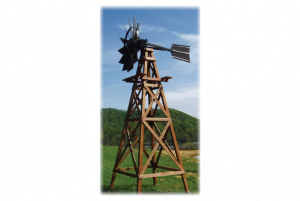 Windmills are pretty but require heavy duty installation
Windmills are pretty but require heavy duty installation
Fountains are quite beneficial, but you need to know which kind to get!
Improve The Overall Quality Of Your Water.
Bottom sediments in a pond emit gasses that might create water quality issues when there is a lack of oxygen in your lake or pond. Many of the variables that contribute to poor water quality can be alleviated by proper aeration by using a water fountain for ponds.
Aids In the Management and Reduction of Excessive Algae Growth
Fountains and the aeration process, which adds oxygen to your body of water, help deprive algae of the nutrients they require to grow and thrive. Fountain aeration efficiently distributes algae spores into the deeper areas of the lake or pond, reducing their available sunlight and time to thrive.
Removes Offensive Smells
Fountains aid in the movement of water from the top to the bottom. Because of the aeration caused by the fountain, the water towards the bottom gets oxygenated. This technique significantly reduces the hydrogen sulfide gas that accumulates at the bottom of lakes and ponds.
Improves The Environment Of Fish Life
Fountains, along with the aeration process they aid in, contribute to a healthy environment in your pond or lake. Fish life and other aquatic animals can thrive, and a healthy ecosystem for your body of water is established and maintained by boosting the oxygen levels both at the top and bottom of your lake or pond.
Reduces Mosquito Activity
Mosquito eggs require calm water conditions to grow. A fountain will maintain a steady water flow in your lake or pond, reducing potential mosquito breeding habitat and functioning as a natural and sustainable mosquito control method.
Reduces Bottom Sediment Buildup
Organic matter decomposes considerably more slowly in low oxygen environments, contributing to the accumulation of silt at the bottom of your lake or pond. Proper aeration through the use of a fountain will aid in the reduction of total organic silt deposition, potentially extending or eliminating the need for future dredging. If not properly aerated, bad algae will decompose faster than good algae, increasing the silt and bad odors.
Improves Fish Habitat
Stratification happens when temperature fluctuations cause separate layers of water to develop at various depths due to differences in water density. Thermal stratification causes periods of oxygen deprivation, which reduces ecosystem efficiency and, in severe circumstances, may result in fish deaths. A healthier environment for fish and other aquatic species will be created by disturbing stratification through lake aeration.
A water fountain’s aeration is an important instrument in the control of your water quality. It is not only a great addition to the views and sounds it provides, but it is also a crucial component of many lake and pond management programs.


